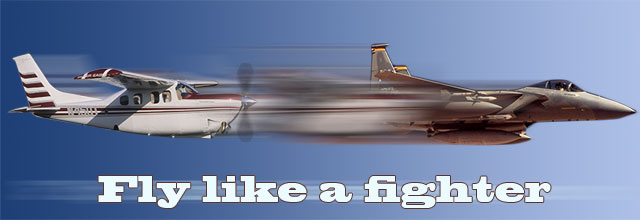 On all of our training sorties we could practice using our missiles and gun without actually shooting anything. Our heads up display (HUD) and radar display would generate the proper symbology for missile and gun parameters, allowing us to review our video and score every shot during our debrief.
On all of our training sorties we could practice using our missiles and gun without actually shooting anything. Our heads up display (HUD) and radar display would generate the proper symbology for missile and gun parameters, allowing us to review our video and score every shot during our debrief.
 One memorable day I got to shoot an actual missile. It was an AIM-9 Sidewinder heat-seeking missile, except the live warhead was replaced with an electronic sensor pack. There was no need to actually blow up every drone out there when the computer could calculate the theoretical blast radius and determine whether it would have taken out the target.
One memorable day I got to shoot an actual missile. It was an AIM-9 Sidewinder heat-seeking missile, except the live warhead was replaced with an electronic sensor pack. There was no need to actually blow up every drone out there when the computer could calculate the theoretical blast radius and determine whether it would have taken out the target.
I was the wingman paired with my flight lead who was carrying an AIM-7 Sparrow radar-guided missile, and our target for the day was the tiny Firebee drone (23 feet long with a 13-foot wingspan). We set up over 30 miles apart and headed toward each other with a closing speed of about 900 knots. We both found the drone on radar, and well before we were in visual range my lead took his shot. Just like in the movies, the missile was kicked off the fuselage station, the motor ignited, and it smoothly accelerated toward the drone.
He then gave me the lead for my shot. Finding the drone on radar was easy. Picking up a tally on this tiny machine had me a little worried. Fortunately, with clear blue skies and a bright sun, I found the drone two miles ahead, to my left, and about 2,000 to 3,000 feet above me. We would pass in only eight seconds.
I lit the afterburners, rolled to about 30 to 40 degrees of left bank, and pulled hard into a modified Immelmann, or half loop. Inverted, with my nose still about 40 degrees above the horizon, I was almost directly behind the drone, a little over a mile behind, and acquired a lock with my radar. Continuing my pull to the horizon, still inverted, now with 30 to 40 degrees of bank upside down, I took my shot. Unlike the AIM-7 motor, which burns with smooth acceleration, the AIM-9 is best likened to a bottle rocket because it reaches Mach 2.5 above your aircraft velocity in the blink of an eye. I was definitely impressed with the loud “whoosh” sound as it left the missile rail and was mesmerized at the serpentine smoke trail it was leaving behind.
Then I remembered there was one more thing I was supposed to do—maneuver away from the smoke trail. In actual combat, seeing the enemy is often paramount to life or death, so staying away from your own smoke trail makes it harder for them to see you. Since I was still inverted, and enjoying the moment (i.e. distracted), it took me a second to figure out how and where to maneuver to get away from the smoke.
We were both successful because we had rehearsed these shots many times in training, but there is nothing like the real thing to gain experience. What do you need to rehearse? What would help you with some simulator time? For those who do simulate events but haven’t flown in actual conditions in a while—like with an instrument approach—consider grabbing a friend or CFII and flying a couple of approaches to near minimums the next time the weather presents itself. Stay sharp!
Larry Brown of Colorado Springs, Colo., is a retired Air Force F-15 pilot who is using the lessons he learned as a fighter pilot as a GA pilot in his Cessna P210. Brown, who has 2,700 hours total time during his 33 years of flying, also was an instructor pilot and flight examiner in the Air Force T-38 and instructor pilot in the T-52, the military’s version of GA’s Diamond DA40. See previous installments of “Fly like a fighter.”



